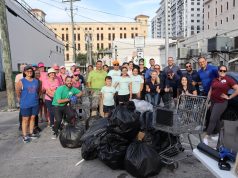You’re sitting in chemistry class. Your professor teaches you that a water molecule is two parts hydrogen and one part oxygen (H2O). Everything else it contains is either naturally occurring minerals like electrolytes… or contaminants. What would you say if you were told that toxic chemicals have been detected in the tap water of Miami, FL? What if you were told that these chemicals are so dangerous that they are measured in parts per trillion? Should you run out and buy a filter? Stock up on bottled water? Move to a different city? If you’re curious about these questions, then this article is for you.

Michael Garrote, Senior Microbiologist for the Alexander Orr Water Treatment Lab of the Miami-Dade Water and Sewer Department, says that their laboratory monitors the water “from the moment they extract it from the wells to the moment that it comes out of the faucet” and that their two laboratories test over 150,000 samples a year so that their customers “feel confident that their drinking water is safe to drink.”
“Bottled water is regulated by the FDA… which is different from local regulations,” says Garrote, “…it’s also packaged in plastic and shipped around the country. The carbon footprint is much larger than tap water.”
According to the Environmental Working Group (EWG), a nonprofit, nonpartisan, activist organization, some of the chemicals tested (PFOA and PFOS) are in the category of PFAS, or Per- and Polyfluoroalkyl Substances. “PFAS are widely used, long lasting chemicals, components of which break down very slowly over time….” writes the EWG, “…Scientific studies have shown that exposure to some PFAS in the environment may be linked to harmful health effects in humans and animals.”
While arguably not as harmful as the highly poisonous lead levels of Flint, Michigan, at the height of its water crisis in 2014, Miami’s water might be safe, but might not be as pure as one would think. Many Miami locals are under the impression that Miami has the cleanest water in the country. “Miami water is as good as it gets,” says one resident Gabriel Suarez, “…I don’t even bother to buy a filter.” Another resident, Angel Mendez, says, “The water in Miami is safe to drink.”

Most of our water in Miami comes from the Biscayne Aquifer, which is a layer of limestone extending about 4,000 square miles under Miami-Dade County and the rest of South Florida. The government website, U.S. Geological Survey, writes, “Uncontaminated water in the Biscayne aquifer is suitable for drinking and most other uses. The water is hard, is a calcium bicarbonate type, and contains small concentrations of chloride and dissolved solids. Locally, the water contains large concentrations of iron. In places in southern Broward County and northern and central Dade County, the water is darkly colored, reflecting large concentrations of organic material.”
The most recent measurement from Miami-Dade County of PFOS and PFOA is 45 ppt. A Duke University Nicholas School of Environment article reads, “Research by Duke and NC State scientists finds most filters are only partially effective at removing PFAS. A few, if not properly maintained, can even make the situation worse.” The EWG writes, in 2016, the [EPA] “issued a non-enforceable lifetime health advisory for PFOA and PFOS in drinking water of 70 ppt.” This means that when it comes to this particular man-made contamination, Miami has safe levels.
However, standards are becoming even more strict, with new recommended levels for PFAS to near zero. As Verisk.com, which focuses on risk analytics and insights, reports, “In June [of 2022], the EPA released new advisories regarding acceptable levels of PFOA and PFOS (two different Per- and poly-fluoroalkyl substances or PFAS) in drinking water. The new advisories set acceptable levels for the two PFAS to 0.004 and 0.02 parts per trillion, respectively. Per experts, exposure to certain PFAS has been linked with negative pregnancy outcomes, cancers, and other negative health outcomes.”
It seems from the evidence gathered that Miami’s water is carefully and closely monitored by its water and sewer department, that it undergoes treatment that makes it abide by EPA standards (perhaps previous ones), that it comes from a source (The Biscayne Aquifer) that is reliably safe and which provides drinking water for most of South Florida. The alternative? Extra filtration at home might be helpful to eliminate some contaminates, but the consensus is that it’s not necessary, at least not necessary in South Florida. As for bottled water, which can leak bisphenol A (BPA) and phthalates into your body and the environment when disposed of, feel confident that you don’t need to spend the extra money.
































